Indirect Enhancement of ALD Thin-Film Properties Induced by the ECAP Modification of an As-Extruded Mg-Ca Alloy
Abstract
:1. Introduction
2. Experimental Methods
2.1. Sample Preparation
2.2. Atomic Layer Deposition
2.3. Characterization and Analysis
2.4. Corrosion Evaluation
3. Results and Discussion
3.1. Equal-Channel Angular Pressing on As-Extrude Mg-Ca Alloy
3.2. Characteristics of ZrO2 Film on the Mg-Ca Alloy
3.3. Corrosion Characteristics
3.3.1. Corroded Surface Morphology
3.3.2. Potentiodynamic Polarization
3.3.3. Electrochemical Impedance Spectroscopy
3.4. Discussion
4. Conclusions
Author Contributions
Funding
Data Availability Statement
Acknowledgments
Conflicts of Interest
References
- Staiger, M.P.; Pietak, A.M.; Huadmai, J.; Dias, G. Magnesium and its alloys as orthopedic biomaterials: A review. Biomaterials 2006, 27, 1728–1734. [Google Scholar] [CrossRef] [PubMed]
- Salahshoor, M.; Guo, Y. Biodegradable Orthopedic Magnesium-Calcium (MgCa) Alloys, Processing, and Corrosion Performance. Materials 2012, 5, 135–155. [Google Scholar] [CrossRef] [PubMed]
- Lambotte, A. L’utilisation du magnesium comme materiel perdu dans l’osteosynthèse. Bull. Société Natl. Chir. 1932, 28, 1325–1334. [Google Scholar]
- Park, J.; Park, M.; Seo, H.; Han, H.S.; Lee, J.Y.; Koo, D.; Kim, K.; Cha, P.R.; Edwards, J.; Kim, Y.W.; et al. A new corrosion-inhibiting strategy for biodegradable magnesium: Reduced nicotinamide adenine dinucleotide (NADH). Sci. Rep. 2018, 8, 124. [Google Scholar] [CrossRef] [PubMed]
- Witte, F.; Ulrich, H.; Rudert, M.; Willbold, E. Biodegradable magnesium scaffolds: Part I: Appropriate inflammatory response. J. Biomed. Mater. Res. Part A 2007, 81, 748–756. [Google Scholar] [CrossRef] [PubMed]
- Ding, Y.; Wen, C.; Hodgson, P.; Li, Y. Effects of alloying elements on the corrosion behavior and biocompatibility of biodegradable magnesium alloys: A review. J. Mater. Chem. B 2014, 2, 1912–1933. [Google Scholar] [CrossRef] [PubMed]
- Mostaed, E.; Vedani, M.; Hashempour, M.; Bestetti, M. Influence of ECAP process on mechanical and corrosion properties of pure Mg and ZK60 magnesium alloy for biodegradable stent applications. Biomatter 2014, 4, 28283. [Google Scholar] [CrossRef] [PubMed]
- Wu, G.; Ibrahim, J.M.; Chu, P.K. Surface design of biodegradable magnesium alloys—A review. Surf. Coat. Technol. 2013, 233, 2–12. [Google Scholar] [CrossRef]
- Mostaed, E.; Hashempour, M.; Fabrizi, A.; Dellasega, D.; Bestetti, M.; Bonollo, F.; Vedani, M. Microstructure, texture evolution, mechanical properties and corrosion behavior of ECAP processed ZK60 magnesium alloy for biodegradable applications. J. Mech. Behav. Biomed. Mater. 2014, 37, 307–322. [Google Scholar] [CrossRef]
- Orlov, D.; Ralston, K.D.; Birbilis, N.; Estrin, Y. Enhanced corrosion resistance of Mg alloy ZK60 after processing by integrated extrusion and equal channel angular pressing. Acta Mater. 2011, 59, 6176–6186. [Google Scholar] [CrossRef]
- Valiev, R.Z.; Langdon, T.G. Principles of equal-channel angular pressing as a processing tool for grain refinement. Prog. Mater. Sci. 2006, 51, 881–981. [Google Scholar] [CrossRef]
- Li, B.; Joshi, S.; Azevedo, K.; Ma, E.; Ramesh, K.T.; Figueiredo, R.B.; Langdon, T.G. Dynamic testing at high strain rates of an ultrafine-grained magnesium alloy processed by ECAP. Mater. Sci. Eng. A 2009, 517, 24–29. [Google Scholar] [CrossRef]
- Jiang, J.; Ma, A.; Saito, N.; Shen, Z.; Song, D.; Lu, F.; Nishida, Y.; Yang, D.; Lin, P. Improving corrosion resistance of RE-containing magnesium alloy ZE41A through ECAP. J. Rare Earths 2009, 27, 848–852. [Google Scholar] [CrossRef]
- Yang, Q.; Yuan, W.; Liu, X. Atomic layer deposited ZrO2 nanofilm on Mg-Sr alloy for enhanced corrosion resistance and biocompatibility. Acta Biomater. 2017, 58, 515–526. [Google Scholar] [CrossRef] [PubMed]
- Liu, X.; Yang, Q.; Li, Z.; Yuan, W.; Zheng, Y.; Cui, Z.; Yang, X.; Yeung, K.W.K.; Wu, S. A combined coating strategy based on atomic layer deposition for enhancement of corrosion resistance of AZ31 magnesium alloy. Appl. Surf. Sci. 2018, 434, 1101–1111. [Google Scholar] [CrossRef]
- Peron, M.; Varone, A.; Fabbri, F.; Ceccone, G.; Luches, P.; Montereali, R.M.; Montenero, A.; Pelliccione, R.; Caramori, S. On the evaluation of ALD TiO2, ZrO2 and HfO2 coatings on corrosion and cytotoxicity performances. J. Magnes. Alloys 2021, 9, 1806–1819. [Google Scholar] [CrossRef]
- Yang, F.; Chang, R.; Webster, T.J. Atomic Layer Deposition Coating of TiO2 Nano-Thin Films on Magnesium-Zinc Alloys to Enhance Cytocompatibility for Bioresorbable Vascular Stents. Int. J. Nanomed. 2019, 14, 9955–9970. [Google Scholar] [CrossRef] [PubMed]
- Kokubo, T.; Takadama, H. How useful is SBF in predicting in vivo bone bioactivity? Biomaterials 2006, 27, 2907–2915. [Google Scholar] [CrossRef] [PubMed]
- Valiev, R.Z.; Alexandrov, I.V.; Islamgaliev, R.K. Producing bulk ultrafine-grained materials by severe plastic deformation. JOM 2006, 58, 33–39. [Google Scholar] [CrossRef]
- Bagherpour, E.; Delshad, M.; Eskandari, H.; Kang, K.; Woo, W. An overview on severe plastic deformation: Research status, techniques classification, microstructure evolution, and applications. Int. J. Adv. Manuf. Technol. 2019, 100, 1647–1694. [Google Scholar] [CrossRef]
- Wan, Y.; Xiong, G.; Luo, H.; He, F.; Huang, Y.; Zhou, X. Preparation and characterization of a new biomedical magnesium–calcium alloy. Mater. Des. 2008, 29, 2034–2037. [Google Scholar] [CrossRef]
- Xu, C.; Furukawa, M.; Horita, Z.; Langdon, T.G. Influence of ECAP on precipitate distributions in a spray-cast aluminum alloy. Acta Mater. 2005, 53, 749–758. [Google Scholar] [CrossRef]
- Skripnyuk, V.; Buchman, E.; Rabkin, E.; Estrin, Y.; Popov, M.; Jorgensen, S. The effect of equal channel angular pressing on hydrogen storage properties of a eutectic Mg–Ni alloy. J. Alloys Compd. 2007, 436, 99–106. [Google Scholar] [CrossRef]
- Valiev, R.Z.; Islamgaliev, R.K.; Alexandrov, I.V. Bulk nanostructured materials from severe plastic deformation. Prog. Mater. Sci. 2000, 45, 103–189. [Google Scholar] [CrossRef]
- Senkov, O.N.; Froes, F.H.; Stolyarov, V.V.; Valiev, R.Z.; Liu, J. Microstructure of Aluminum-Iron Alloys Subjected to Severe Plastic Deformation. Scr. Mater. 1998, 38, 1511–1516. [Google Scholar] [CrossRef]
- Ramirez, L.; Mecartney, M.; Krumdieck, S. Nanocrystalline ZrO2 thin films on silicon fabricated by pulsed-pressure metalorganic chemical vapor deposition (PP-MOCVD). J. Mater. Res. 2008, 23, 2202–2211. [Google Scholar] [CrossRef]
- Wang, S.Y.; Lee, D.Y.; Huang, T.Y.; Wu, J.W.; Tseng, T.Y. Controllable oxygen vacancies to enhance resistive switching performance in a ZrO2-based RRAM with embedded Mo layer. Nanotechnology 2010, 21, 495201. [Google Scholar] [CrossRef] [PubMed]
- Wang, Y.M.; Li, Y.S.; Wong, P.C.; Mitchell, K.A.R. XPS studies of the stability and reactivity of thin films of oxidized zirconium. Appl. Surf. Sci. 1993, 72, 237–244. [Google Scholar] [CrossRef]
- Lin, P.C.; Lin, K.F.; Chiu, C.; Semenov, V.I.; Lin, H.C.; Chen, M.J. Effect of atomic layer plasma treatment on TALD-ZrO2 film to improve the corrosion protection of Mg-Ca alloy. Surf. Coat. Technol. 2021, 427, 127811. [Google Scholar] [CrossRef]
- Hausmann, D.M.; Gordon, R.G. Surface morphology and crystallinity control in the atomic layer deposition (ALD) of hafnium and zirconium oxide thin films. J. Cryst. Growth 2003, 249, 251–261. [Google Scholar] [CrossRef]
- Shahabi-Navid, M.; Cao, Y.; Svensson, J.E.; Allanore, A.; Birbilis, N.; Johansson, L.G.; Esmaily, M. On the early stages of localised atmospheric corrosion of magnesium–aluminium alloys. Sci. Rep. 2020, 10, 20972. [Google Scholar] [CrossRef] [PubMed]
- Maltseva, A.; Shkirskiy, V.; Lefèvre, G.; Volovitch, P. Effect of pH on Mg(OH)2 film evolution on corroding Mg by in situ kinetic Raman mapping (KRM). Corros. Sci. 2019, 153, 272–282. [Google Scholar] [CrossRef]
- Xin, Y.; Liu, C.; Zhang, X.; Tang, G.; Tian, X.; Chu, P.K. Corrosion behavior of biomedical AZ91 magnesium alloy in simulated body fluids. J. Mater. Res. 2007, 22, 2004–2011. [Google Scholar] [CrossRef]
- Lin, C.H.; Duh, J.G. Electrochemical impedance spectroscopy (EIS) study on corrosion performance of CrAlSiN coated steels in 3.5wt.% NaCl solution. Surf. Coat. Technol. 2009, 204, 784–787. [Google Scholar] [CrossRef]
- Liu, X.; Xiong, J.; Lv, Y.; Zuo, Y. Study on corrosion electrochemical behavior of several different coating systems by EIS. Prog. Org. Coat. 2009, 64, 497–503. [Google Scholar] [CrossRef]
- Ribeiro, D.V.; Abrantes, J.C.C. Application of electrochemical impedance spectroscopy (EIS) to monitor the corrosion of reinforced concrete: A new approach. Constr. Build. Mater. 2016, 111, 98–104. [Google Scholar] [CrossRef]
- Huh, J.H.; Kim, S.H.; Chu, J.H.; Kim, S.Y.; Kim, J.H.; Kwon, S.Y. Enhancement of seawater corrosion resistance in copper using acetone-derived graphene coating. Nanoscale 2014, 6, 4379–4386. [Google Scholar] [CrossRef] [PubMed]
- Li, X.; Weng, Z.; Yuan, W.; Luo, X.; Wong, H.M.; Liu, X.; Wu, S.; Yeung, K.W.K.; Zheng, Y.; Chu, P.K. Corrosion resistance of dicalcium phosphate dihydrate/poly(lactic-co-glycolic acid) hybrid coating on AZ31 magnesium alloy. Corros. Sci. 2016, 102, 209–221. [Google Scholar] [CrossRef]
- Chen, J.; Wang, J.; Han, E.; Dong, J.; Ke, W. AC impedance spectroscopy study of the corrosion behavior of an AZ91 magnesium alloy in 0.1 M sodium sulfate solution. Electrochim. Acta 2007, 52, 3299–3309. [Google Scholar] [CrossRef]
- Jorcin, J.B.; Orazem, M.E.; Pébère, N.; Tribollet, B. CPE analysis by local electrochemical impedance spectroscopy. Electrochim. Acta 2006, 51, 1473–1479. [Google Scholar] [CrossRef]
- Ceresoli, D.; Vanderbilt, D. Structural and dielectric properties of amorphous ZrO2 and HfO2. Phys. Rev. B 2006, 74, 125108. [Google Scholar] [CrossRef]
- Yi, S.H.; Huang, K.W.; Lin, H.C.; Chen, M.J. Low-temperature crystallization and paraelectric–ferroelectric phase transformation in nanoscale ZrO2 thin films induced by atomic layer plasma treatment. J. Mater. Chem. C 2020, 8, 3669–3677. [Google Scholar] [CrossRef]
- Huang, K.W.; Chang, T.J.; Wang, C.Y.; Yi, S.H.; Wang, C.I.; Jiang, Y.S.; Yin, Y.T.; Lin, H.C.; Chen, M.J. Leakage current lowering and film densification of ZrO2 high-k gate dielectrics by layer-by-layer, in-situ atomic layer hydrogen bombardment. Mater. Sci. Semicond. Process. 2020, 109, 104933. [Google Scholar] [CrossRef]
- Ming, Y.; You, G.; Yao, F.; Zeng, S.; Zhang, J.; Zhao, J.; Zeng, W. High-temperature oxidation of Mg–Ca alloy: Experimentation and density functional theory. Corros. Sci. 2022, 196, 110046. [Google Scholar] [CrossRef]
- You, B.-S.; Park, W.-W.; Chung, I.-S.; Kim, N.J. The effect of calcium additions on the oxidation behavior in magnesium alloys. Scr. Mater. 2000, 42, 1089–1094. [Google Scholar] [CrossRef]
- Craft, H.S.; Collazo, R.; Losego, M.D.; Sitar, Z.; Maria, J.P. Surface water reactivity of polycrystalline MgO and CaO films investigated using x-ray photoelectron spectroscopy. J. Vac. Sci. Technol. A 2008, 26, 1507–1510. [Google Scholar] [CrossRef]
- Wagner, C.D.; Zatko, D.A.; Raymond, R.H. Use of the oxygen KLL Auger lines in identification of surface chemical states by electron spectroscopy for chemical analysis. Anal. Chem. 1980, 52, 1445–1451. [Google Scholar] [CrossRef]
- Felten, M.; Nowak, J.; Grünewald, P.; Schäfer, F.; Motz, C.; Zander, D. The Role of Native Oxides on the Corrosion Mechanism of Laves Phases in Mg–Al–Ca Composites. In Magnesium 2021: Proceedings of the 12th International Conference on Magnesium Alloys and Their Applications; Springer: Cham, Switzerland, 2021; pp. 217–225. [Google Scholar]
- Doll, K.; Dolg, M.; Stoll, H. Correlation effects in MgO and CaO: Cohesive energies and lattice constants. Phys. Rev. B 1996, 54, 13529–13535. [Google Scholar] [CrossRef] [PubMed]
- Materlik, R.; Künneth, C.; Kersch, A. The Origin of Ferroelectricity in Hf1-xZrxO2: A Computational Investigation and a Surface Energy Model. J. Appl. Phys. 2015, 117, 134109. [Google Scholar] [CrossRef]
- Lee, S.M.; Yum, J.H.; Larsen, E.S.; Lee, W.C.; Kim, S.K.; Bielawski, C.W.; Oh, J. Advanced Silicon-on-Insulator: Crystalline Silicon on Atomic Layer Deposited Beryllium Oxide. Sci. Rep. 2017, 7, 13205. [Google Scholar]
- Aarik, J.; Aidla, A.; Mändar, H.; Uustare, T. Atomic layer deposition of titanium dioxide from TiCl4 and H2O: Investigation of growth mechanism. Appl. Surf. Sci. 2001, 172, 148–158. [Google Scholar] [CrossRef]
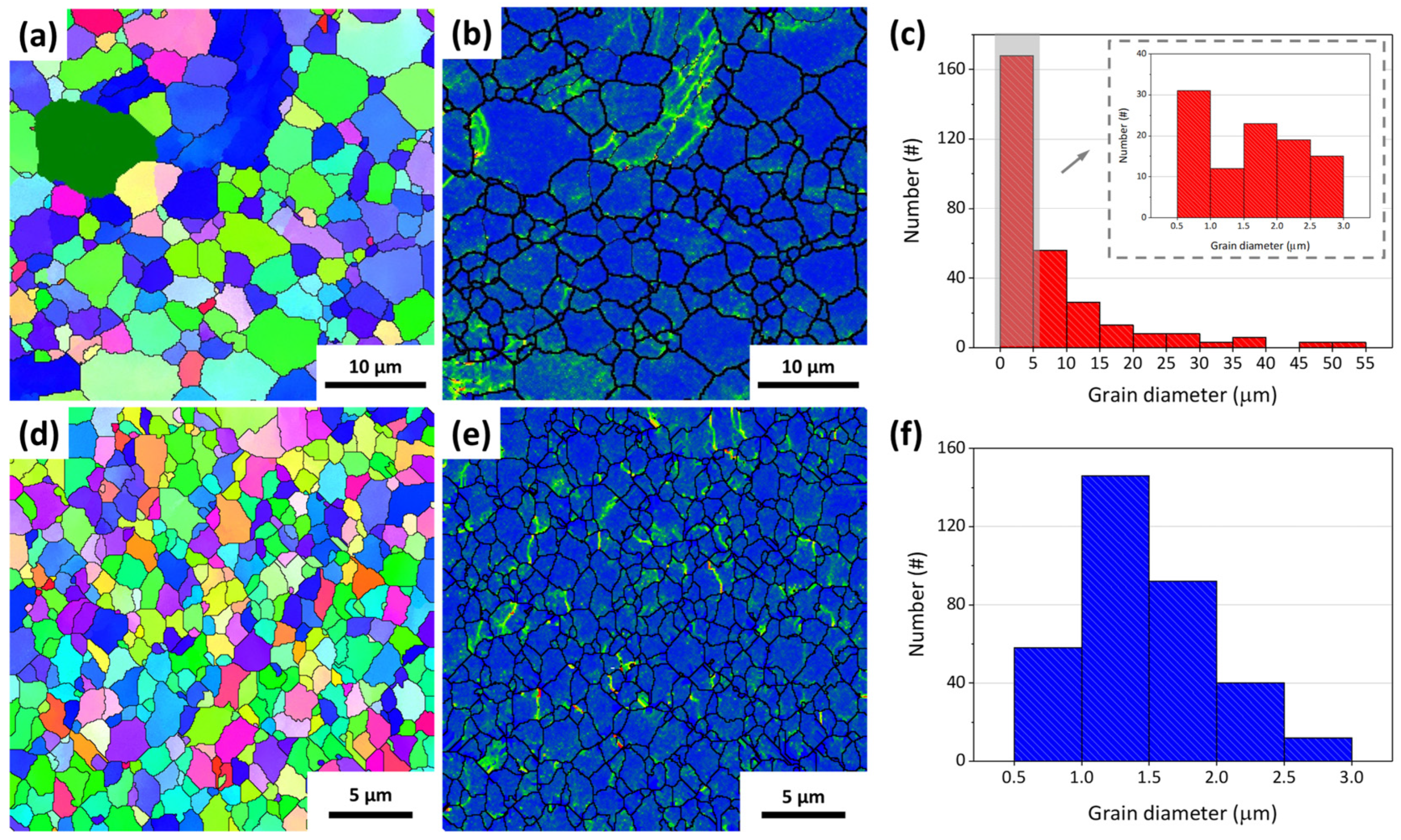

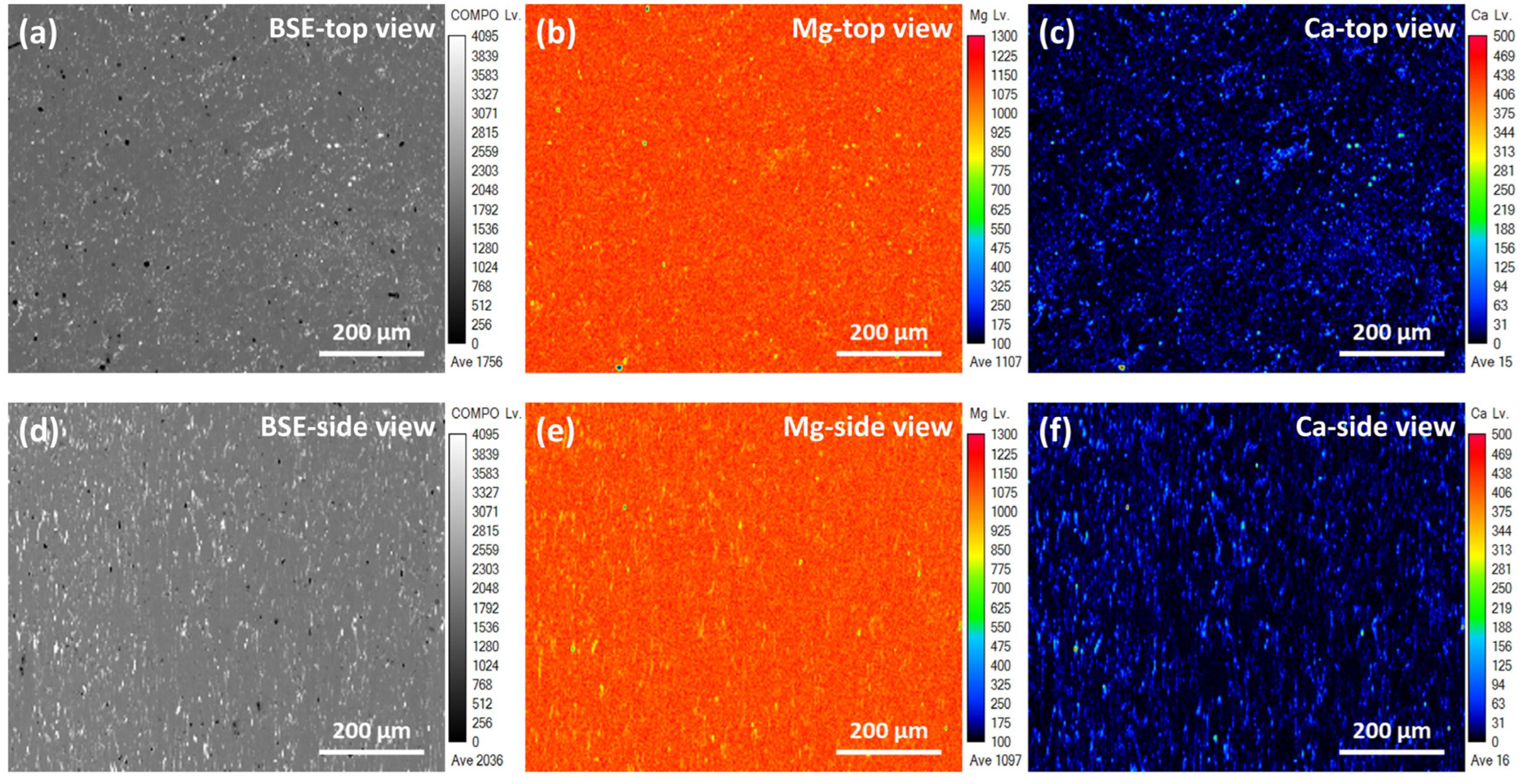
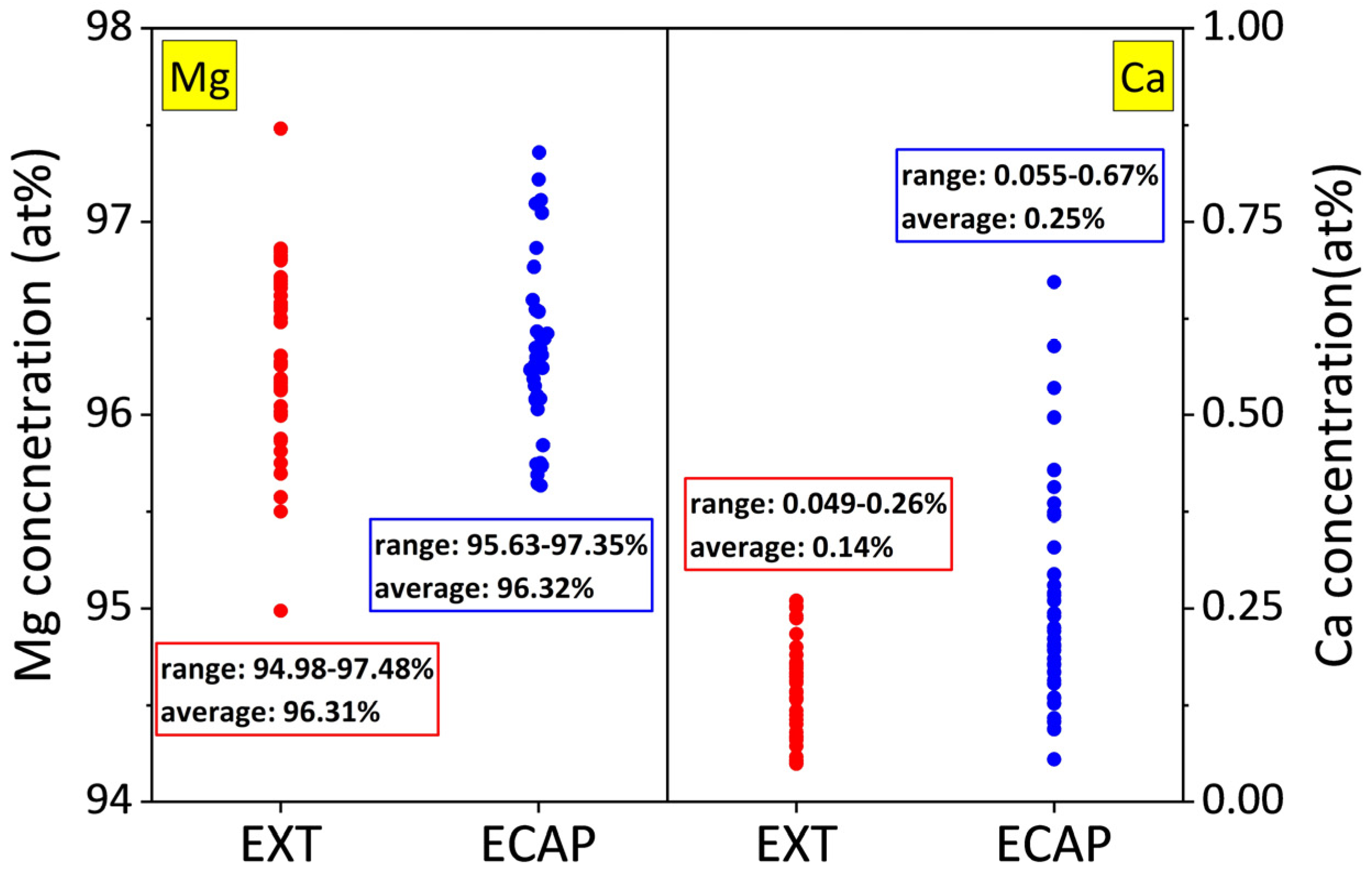
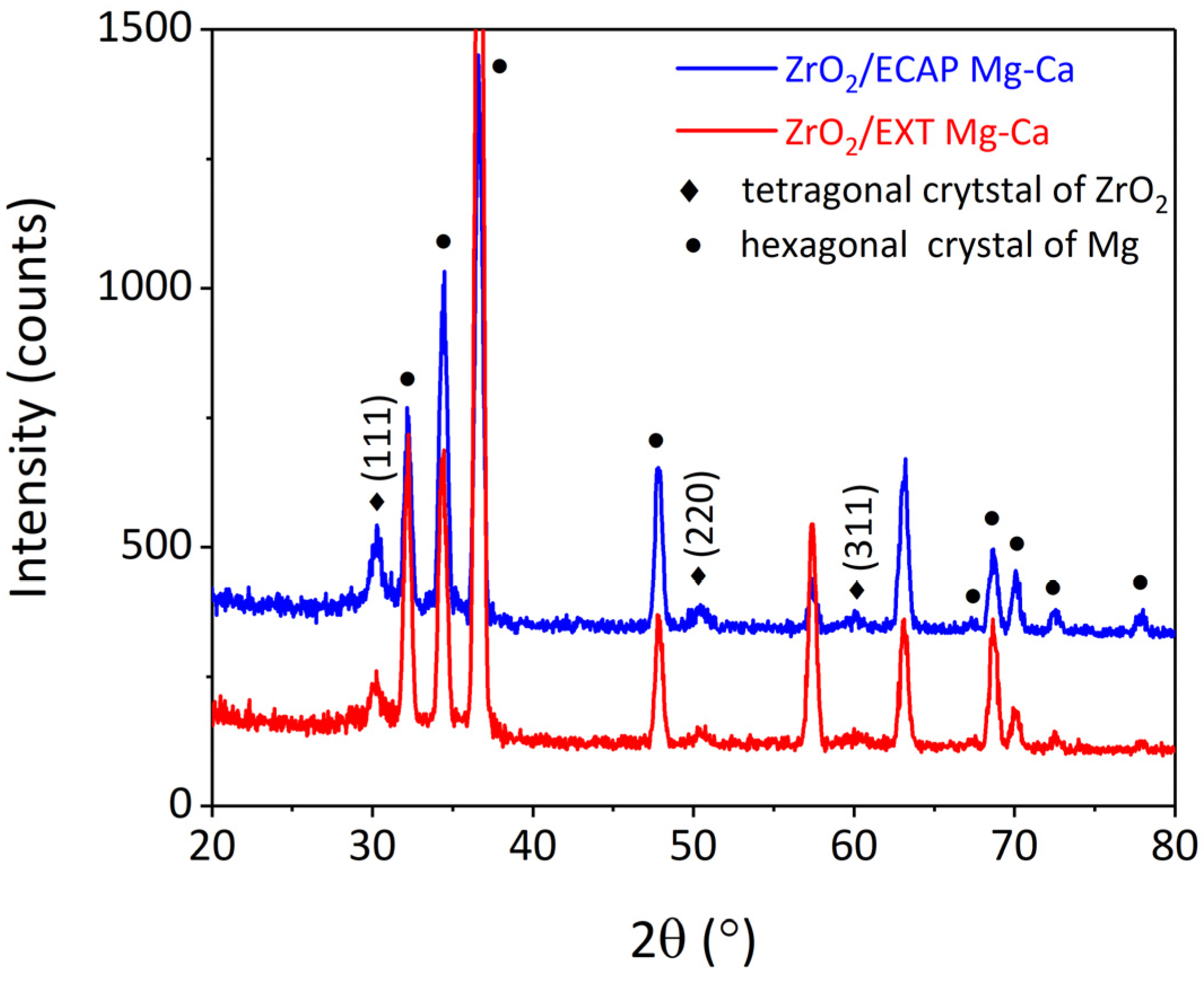
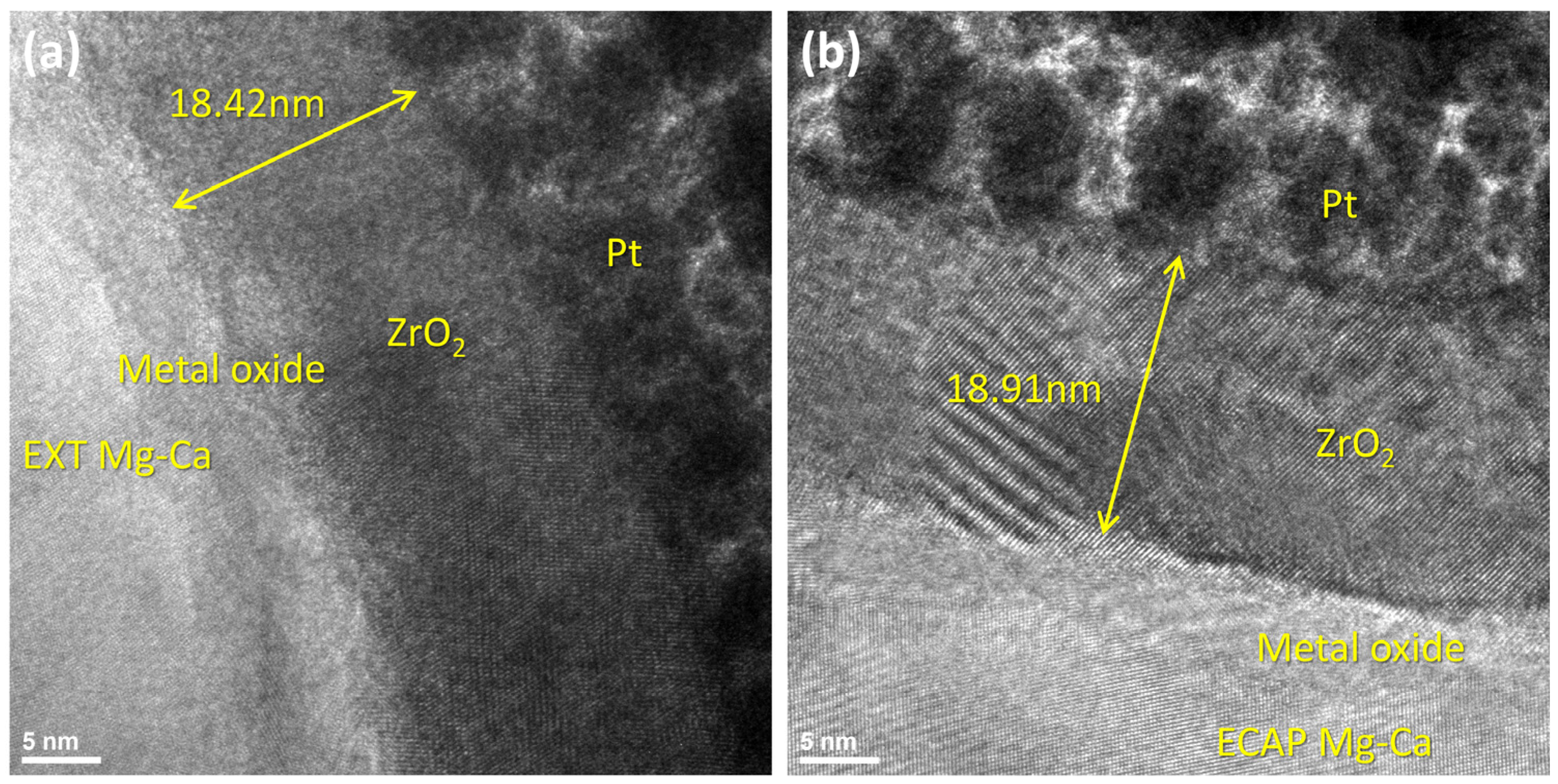
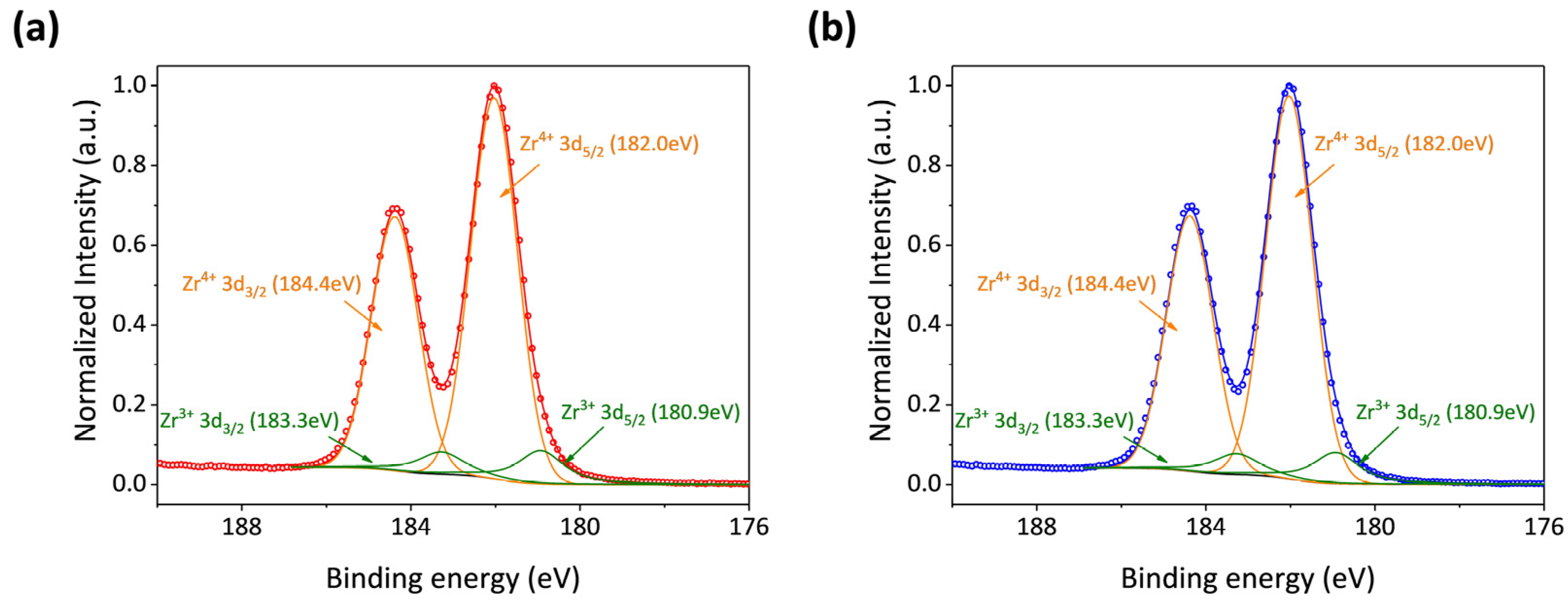
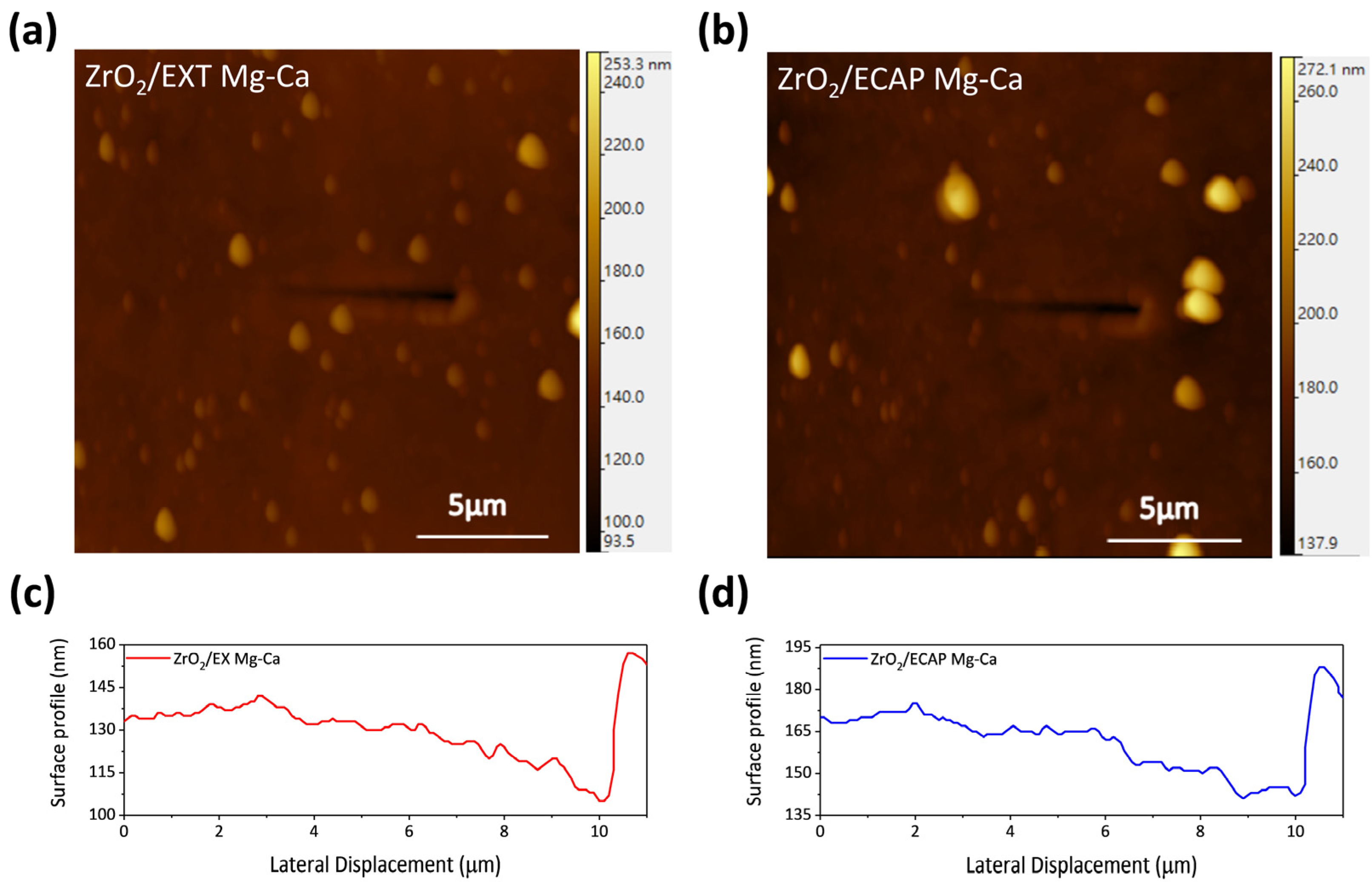

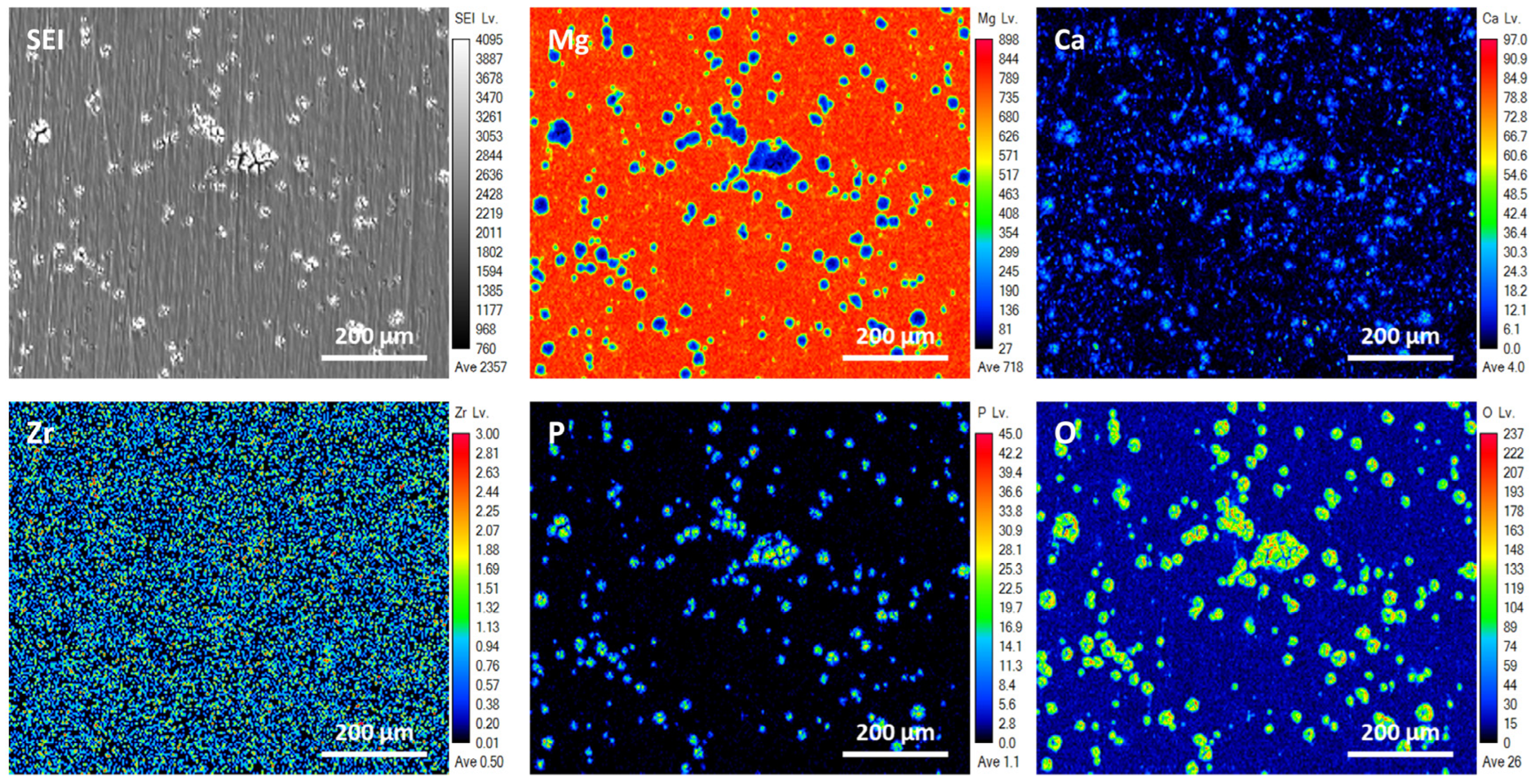
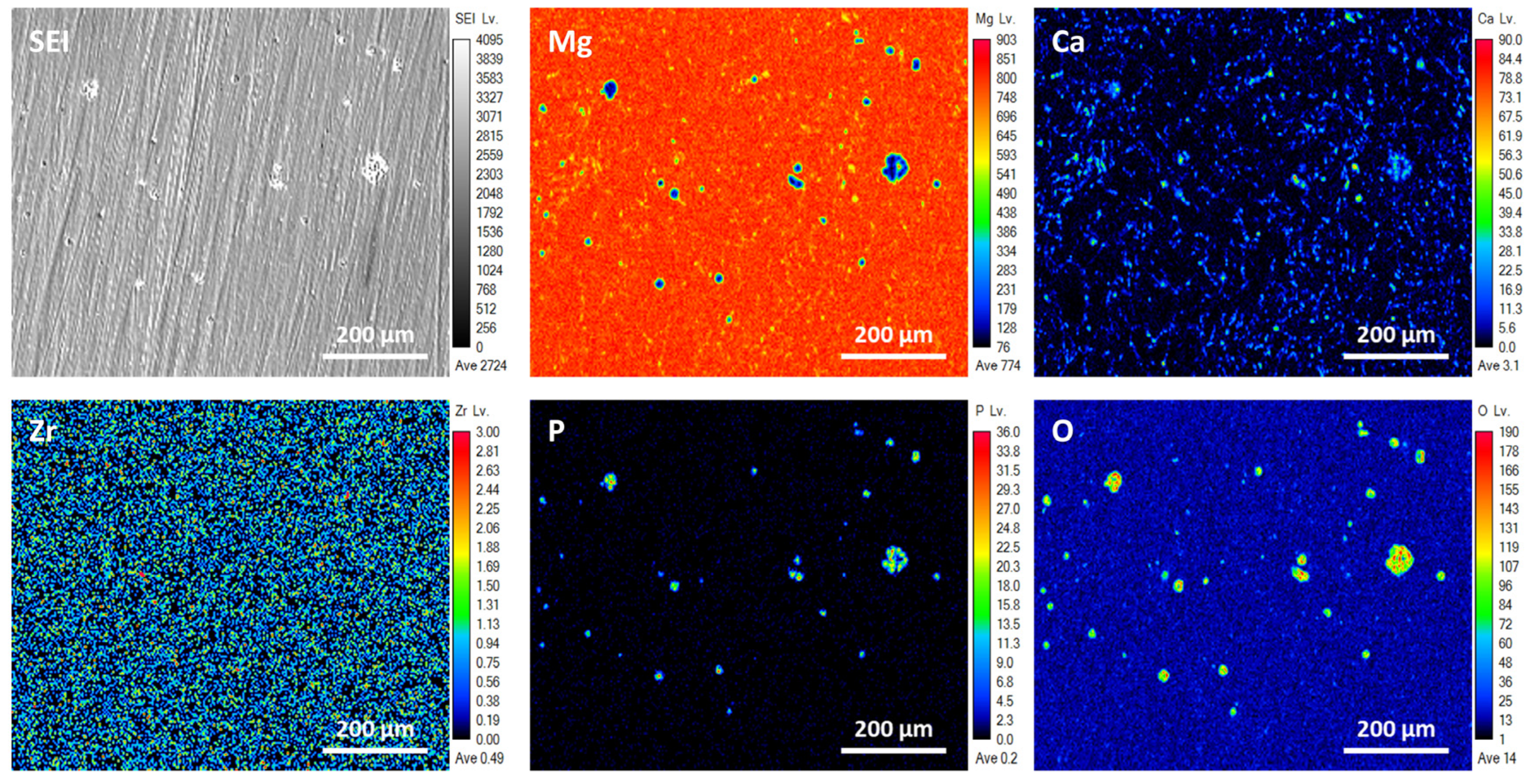

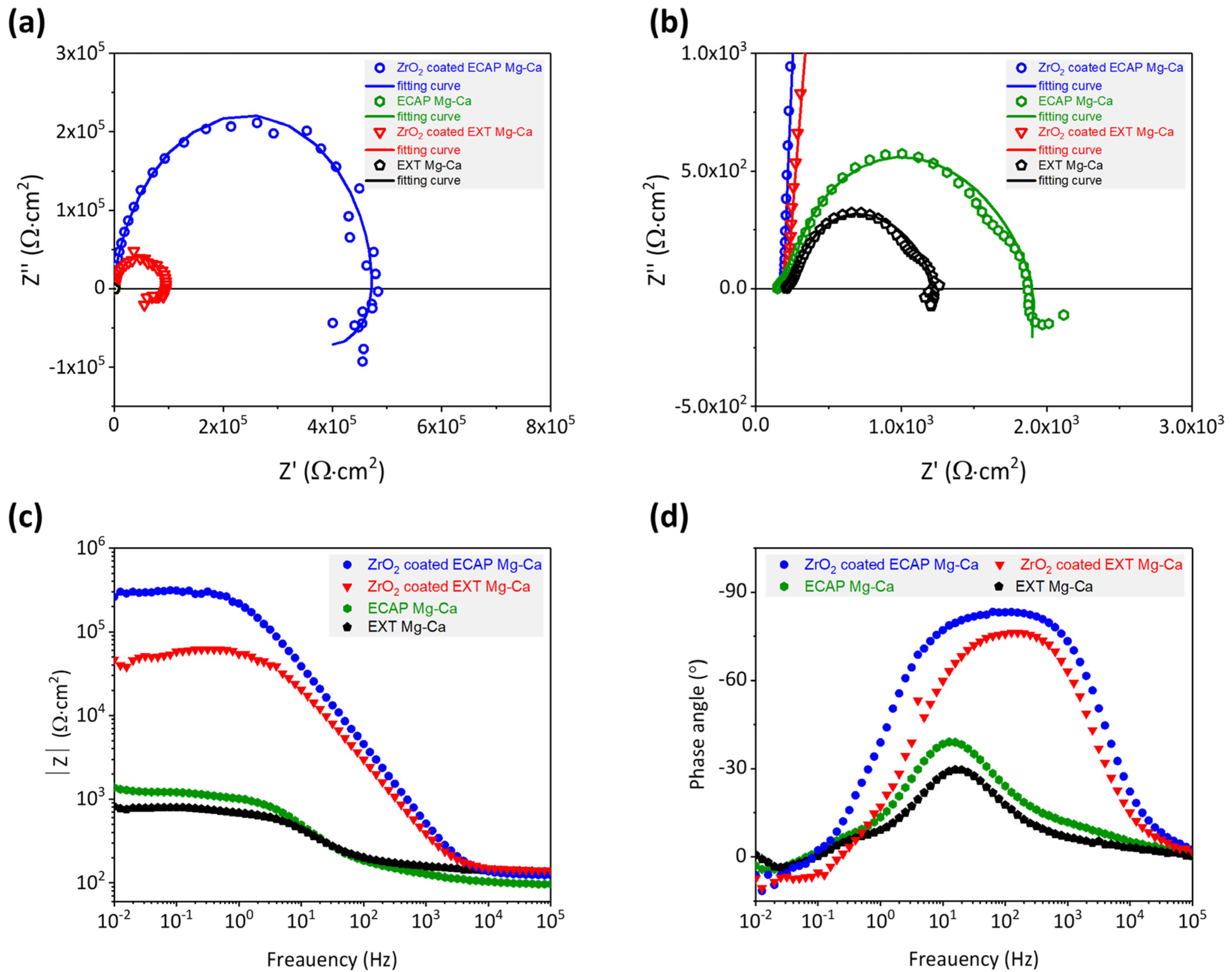
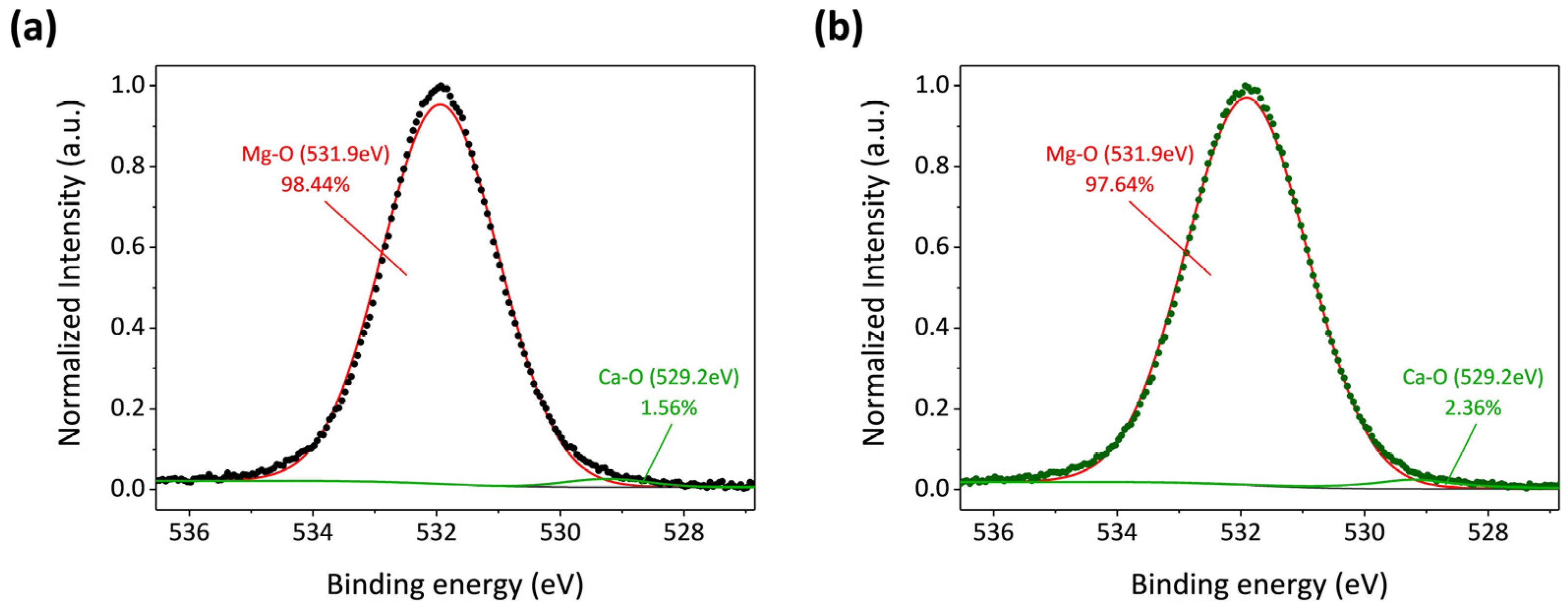
| Sample | (111) | (220) | (311) |
|---|---|---|---|
| ZrO2 film on EXT Mg-Ca alloy | 168.7 | 73.0 | 77.3 |
| ZrO2 film on ECAP Mg-Ca alloy | 210.1 | 87.5 | 77.4 |
| Sample | EXT Mg-Ca | ZrO2/EXT Mg-Ca | ECAP Mg-Ca | ZrO2/ECAP Mg-Ca |
|---|---|---|---|---|
| Icorr (A/cm2) | 9.39 × 10−5 | 4.67 × 10−7 | 7.66 × 10−5 | 1.34 × 10−7 |
| Ecorr (V) | −1.97 | −1.61 | −1.96 | −1.72 |
| Sample | Rs (Ω·cm2) | Qf (F.s−n·cm2) | nf | Rf (Ω·cm2) | Cint (F.s−n·cm2) | Rt (Ω·cm2) | L (H·cm2) | RL (Ω·cm2) |
|---|---|---|---|---|---|---|---|---|
| EXT Mg-Ca | 208 | 8.4 × 10−5 | 0.60 | 1.5 × 102 | 9.2 × 10−6 | 9.0 × 102 | 5.1 × 104 | 7.4 × 103 |
| ZrO2/EXT Mg-Ca | 216 | 5.4 × 10−7 | 0.93 | 6.0 × 104 | 6.5 × 10−7 | 3.3 × 104 | 1.4 × 105 | 3.0 × 103 |
| ECAP Mg-Ca | 147 | 6.2 × 10−5 | 0.62 | 2.5 × 102 | 9.2 × 10−6 | 1.6 × 103 | 1.6 × 105 | 3.0 × 10−3 |
| ZrO2/ECAP Mg-Ca | 190 | 2.9 × 10−7 | 0.96 | 3.3 × 105 | 2.9 × 10−7 | 1.5 × 105 | 2.3 × 106 | 4.0 × 10−2 |
| Sample | EXT Mg-Ca | ZrO2/EXT Mg-Ca | ECAP Mg-Ca | ZrO2/ECAP Mg-Ca |
|---|---|---|---|---|
| Rp (Ω·cm2) | 1.1 × 103 | 9.3 × 104 | 1.9 × 103 | 4.8 × 105 |
Disclaimer/Publisher’s Note: The statements, opinions and data contained in all publications are solely those of the individual author(s) and contributor(s) and not of MDPI and/or the editor(s). MDPI and/or the editor(s) disclaim responsibility for any injury to people or property resulting from any ideas, methods, instructions or products referred to in the content. |
© 2024 by the authors. Licensee MDPI, Basel, Switzerland. This article is an open access article distributed under the terms and conditions of the Creative Commons Attribution (CC BY) license (https://creativecommons.org/licenses/by/4.0/).
Share and Cite
Lin, P.-C.; Li, J.-Y.; Chen, H.-J.; Lin, K.; Chen, M.-J.; Lin, K.-M.; Lin, H.-C. Indirect Enhancement of ALD Thin-Film Properties Induced by the ECAP Modification of an As-Extruded Mg-Ca Alloy. Micromachines 2024, 15, 1006. https://doi.org/10.3390/mi15081006
Lin P-C, Li J-Y, Chen H-J, Lin K, Chen M-J, Lin K-M, Lin H-C. Indirect Enhancement of ALD Thin-Film Properties Induced by the ECAP Modification of an As-Extruded Mg-Ca Alloy. Micromachines. 2024; 15(8):1006. https://doi.org/10.3390/mi15081006
Chicago/Turabian StyleLin, Pi-Chen, Jun-Yu Li, Hou-Jen Chen, Kaifan Lin, Miin-Jang Chen, Kun-Ming Lin, and Hsin-Chih Lin. 2024. "Indirect Enhancement of ALD Thin-Film Properties Induced by the ECAP Modification of an As-Extruded Mg-Ca Alloy" Micromachines 15, no. 8: 1006. https://doi.org/10.3390/mi15081006





